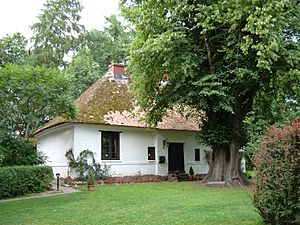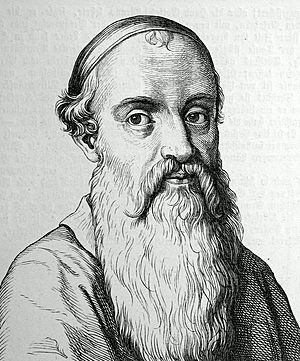Menno Simons facts for kids
Quick facts for kids Menno Simons |
|
|---|---|

"Menno Simons from Friesland"
1608 engraving by Christoffel van Sichem |
|
| Church | Mennonites |
| Personal details | |
| Born | 1496 Witmarsum, Friesland, Holy Roman Empire |
| Died | 31 January 1561 (aged 64 or 65) Wüstenfelde, Duchy of Holstein, Holy Roman Empire |
| Buried | Bad Oldesloe |
| Denomination | Roman Catholic (until 1536), Anabaptist (from 1536) |
| Spouse | Geertruydt Jansdochter |
| Children | Two daughters, one son |
| Profession | Catholic priest (until 1536), Anabaptist minister and author (from 1536) |
Menno Simons (1496 – January 31, 1561) was a Roman Catholic priest from the Friesland area. This region is part of the Low Countries (modern-day Netherlands). He later left the Catholic Church and became an important leader for the Anabaptist religious group.
Menno Simons lived during the time of the Protestant Reformation. This was a period when many people questioned the Catholic Church. His followers became known as Mennonites, named after him.
His name "Menno Simons" is Dutch. In the Frisian language, it is "Minne Simens." The "s" at the end means "son of Simen."
Contents
Menno Simons' Life Story
Early Years and Education
Menno Simons was born in 1496 in Witmarsum, Friesland. This area was then part of the Holy Roman Empire. We don't know much about his childhood. We know he grew up in a poor farming family. His father's name was Simon, and he had a brother named Pieter.
Menno grew up in a land troubled by war. Friesland faced many conflicts in the late 1400s and early 1500s. Soldiers often raided the land. They tried to force the people to accept new rulers. Eventually, the region came under the control of Emperor Charles V.
Menno learned Latin and some Greek. He also studied the writings of early Christian leaders. He became a priest. Interestingly, he had never read the Bible before or during his training. He later said he was "stupid" for not reading it sooner.
Becoming a Priest and a Big Change
Menno became a Roman Catholic priest in 1515 or 1516. He then worked as a chaplain in his father's village, Pingjum, starting in 1524.
Around 1526 or 1527, Menno began to question some church teachings. He started to read the Bible very carefully. He realized he had not studied it before, even as a priest. This led him to new ideas about faith.
In 1531, Menno heard about a man named Sicke Freerks Snijder. This man was executed for being "rebaptized." This idea of "rebaptism" sounded very strange to Menno. He searched the Bible again. He also talked with his pastor and read works by Martin Luther. Menno began to believe that infant baptism was not taught in the Bible.
He then met Anabaptists. These were people who believed in "believer's baptism." This meant people should choose to be baptized as adults. Menno was drawn to their strong faith.
A Difficult Time and New Path
In 1535, Menno's brother Pieter was killed. Pieter was with a group of Anabaptists who took over a Catholic monastery. This event was known as the Oldeklooster siege. About 300 Anabaptists, led by Jan van Geelen, seized the monastery. They hoped to take control of the whole province.
However, imperial forces attacked the monastery. After a tough battle, the monastery was taken back. Many Anabaptists lost their lives. Some were executed later. Menno's brother Pieter was among those who died.
After his brother's death, Menno felt very sad and confused. He prayed deeply, asking God for guidance. He wanted to change his life.
On January 12, 1536, Menno Simons left the Catholic Church. He decided to join the Anabaptists. He was likely baptized as an adult soon after. By October 1536, people knew he was an Anabaptist. He was ordained as a minister around 1537.
Menno did not agree with the violence of some Anabaptist groups. He believed in peace. His teachings focused on living separately from the "worldly" way of life. He taught that baptism should be a symbol of a person's choice to follow Christ.
Menno quickly became an important leader. By 1544, people started calling Dutch Anabaptists "Mennonites."
Menno Simons died on January 31, 1561, in Wüstenfelde, Holstein. He was 64 or 65 years old. He was married to Gertrude, and they had two daughters and one son.
Menno Simons' Beliefs
Menno Simons had a huge impact on the Anabaptist movement. Some historians divide the history of Anabaptism into three parts: before Menno, during Menno, and after Menno. He helped the movement survive and grow during difficult times.
Church Discipline
Menno Simons believed that church discipline was very important. This meant that the church community should help its members live according to Christian teachings. If someone sinned, the whole church would help them correct their path. He believed that people could become more like Christ after they chose to follow him.
The Church as Christ's Bride
Menno Simons often used the image of the "bride of Christ" to describe the church. He saw the church as pure and devoted to Christ, just like a loving bride. This idea also applied to marriage between a man and a woman. He believed that a woman should be devoted to her husband.
Adult Baptism
Anabaptists believed that only adults should be baptized. This was different from Martin Luther, who supported infant baptism. Menno Simons believed that the church should be made up of people who freely choose to follow Christ. He saw baptism as a public sign of this personal commitment. He also believed that becoming holy was a lifelong journey.
A Focus on Peace
While some Anabaptists in the 1500s used violence, Dutch Mennonites generally became peaceful. Menno Simons himself was reluctant to get into arguments. He taught that his followers should avoid disputes. He believed in living a quiet and peaceful life.
Living Differently
Menno Simons did not support traditional practices like withdrawing from society or self-punishment. However, his teachings encouraged Anabaptists to live differently from the rest of society. He wanted them to have new ways of relating to others and to God. This helped them create their own unique community.
Menno Simons' Writings
- Van de Geestlijke Verrijsenisse (around 1536; The Spiritual Resurrection)
- De nieuwe Creatuere (around 1537; The New Birth)
- Christelycke leringhen op den 25. Psalm (around 1538; Meditation on the Twenty-Fifth Psalm)
- Why I Do Not Cease Teaching and Writing (1539)
- Dat Fundament des Christelycken leers (1539–40; Foundation of Christian Doctrine)
See also
In Spanish: Menno Simons para niños



